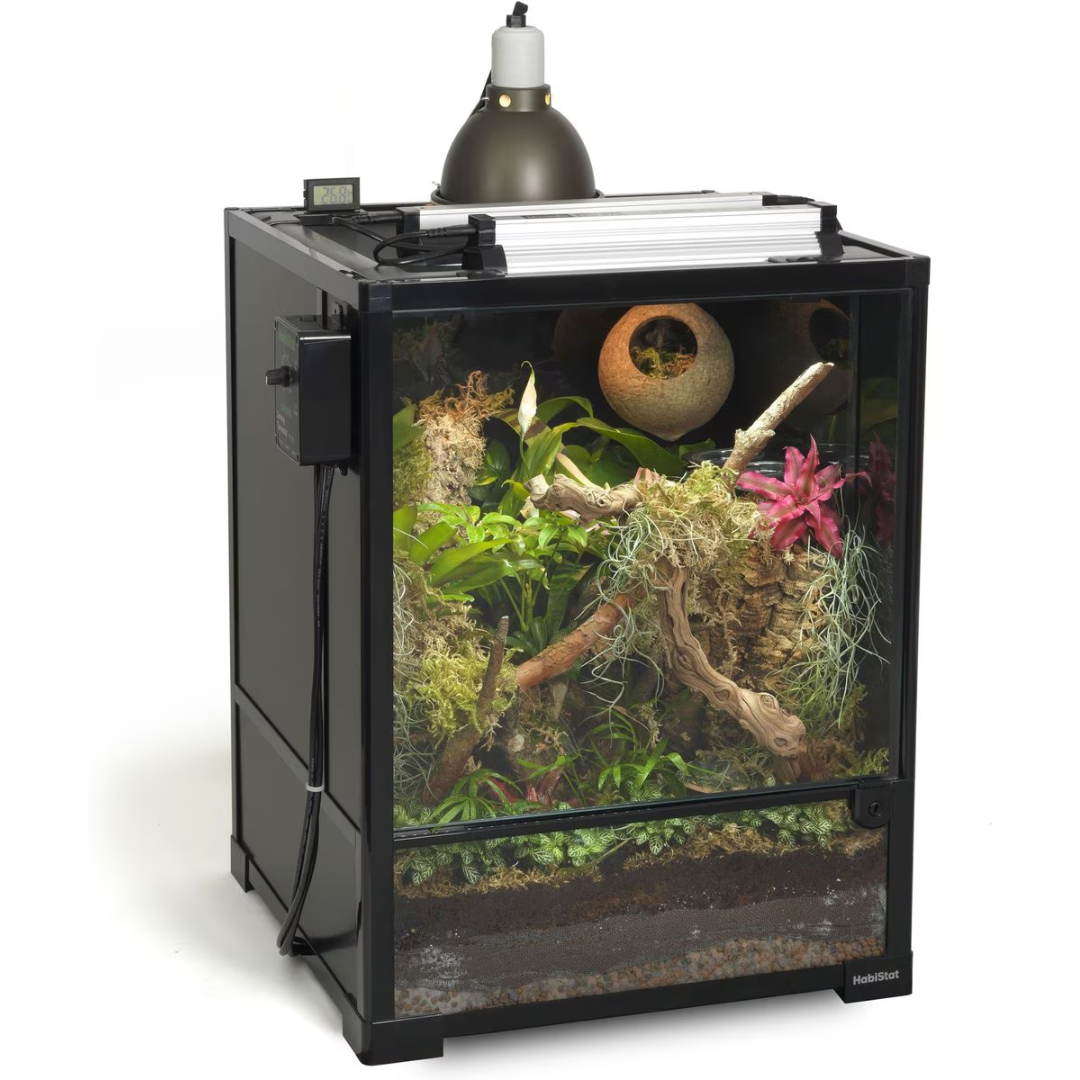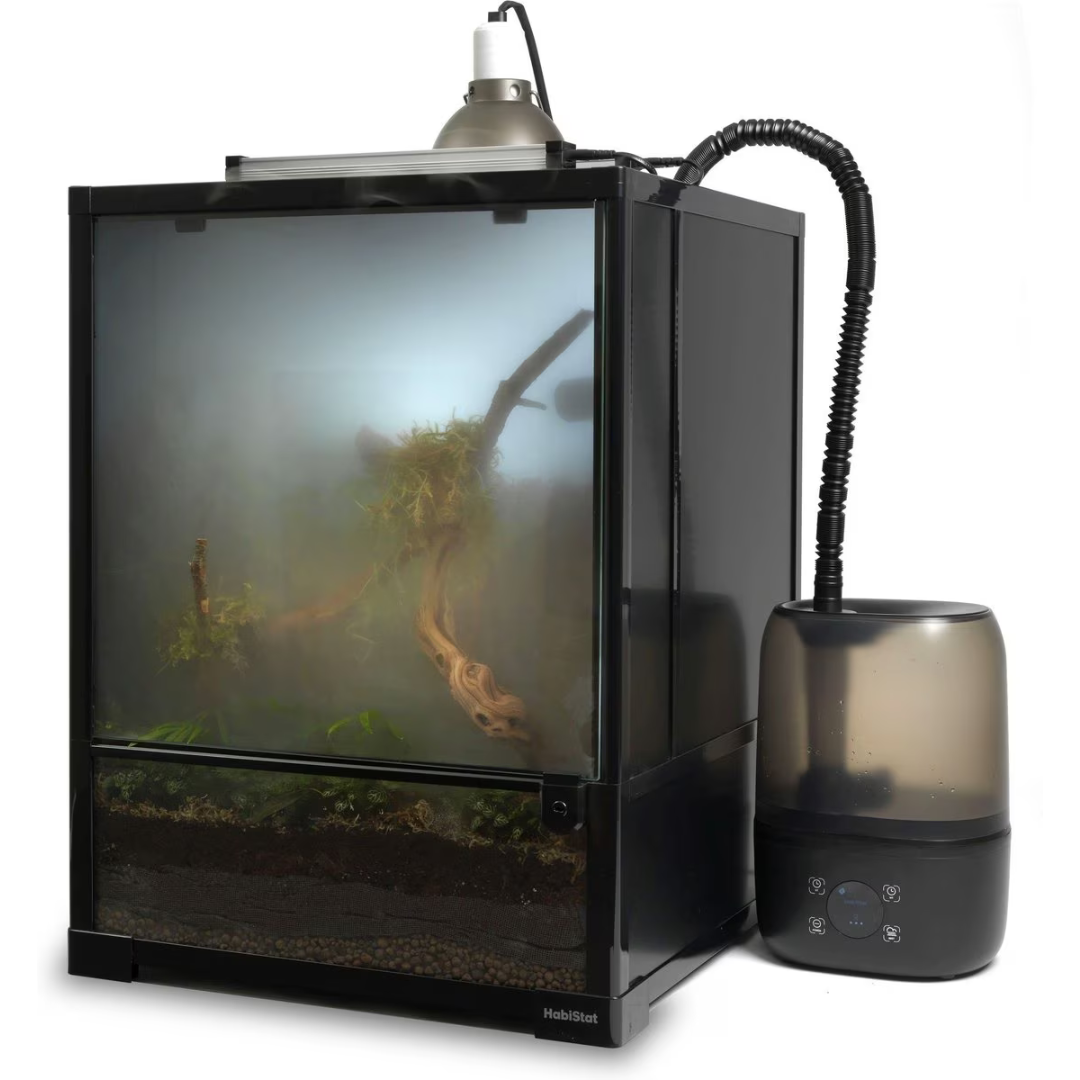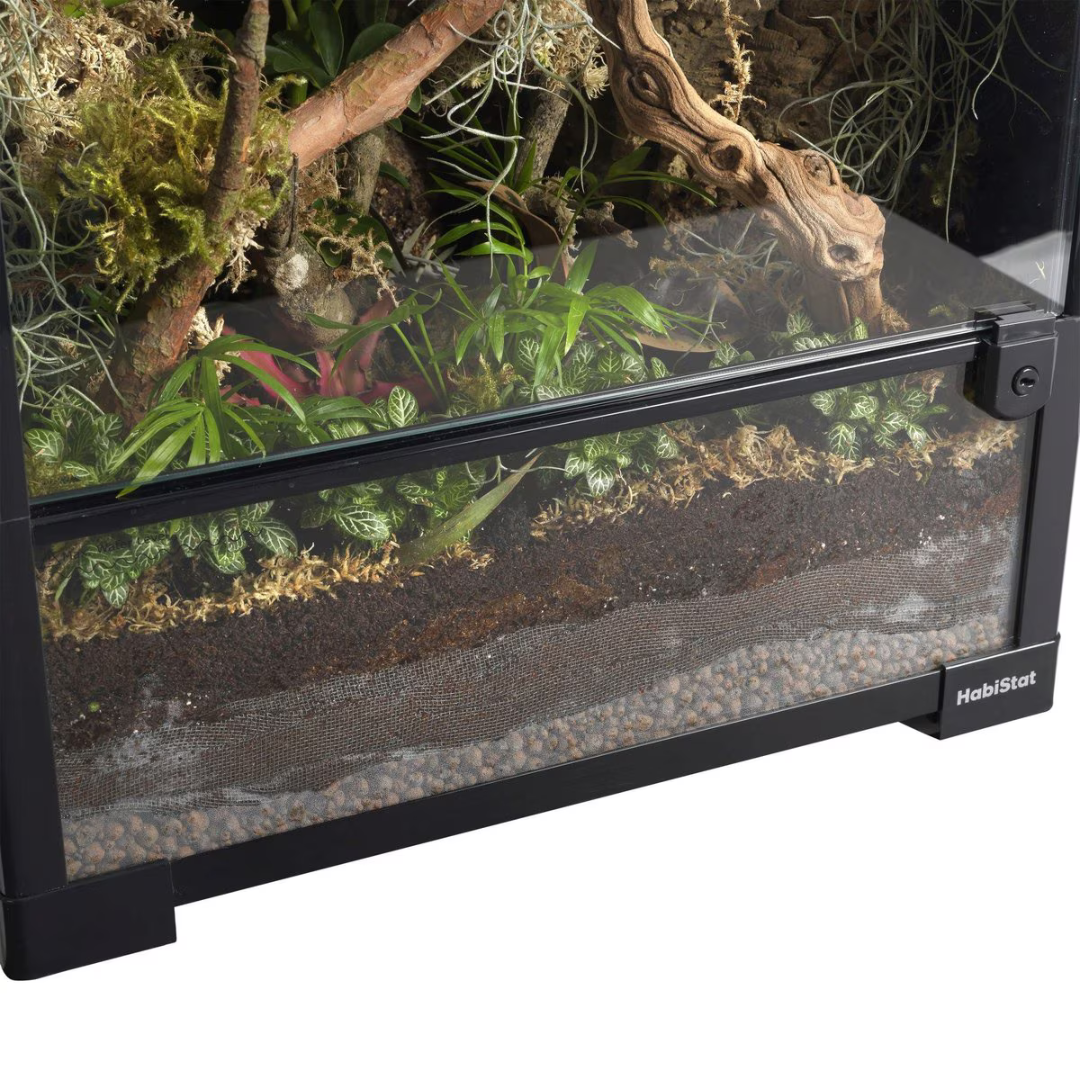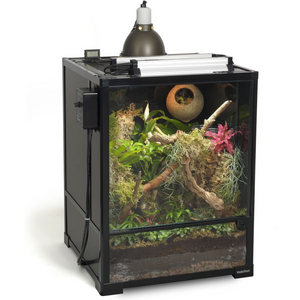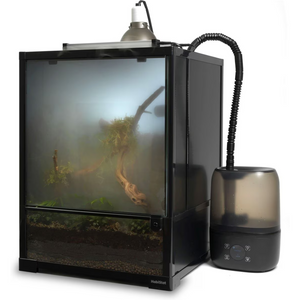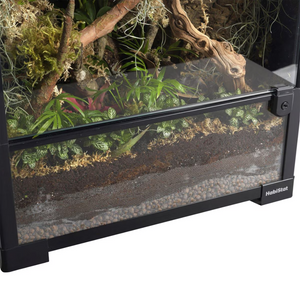Natural History
The Eastern spiny-tailed gecko is a medium-sized terrestrial gecko endemic to arid and semi-arid regions of inland Australia. It undergoes a series of defined life stages beginning at hatching. Hatchlings typically measure around 2 inches in total length and exhibit a brighter coloration than adults, often with more distinct banding and pigmentation. They grow steadily over the first year of life, reaching sexual maturity at approximately 12 to 18 months under optimal conditions. Adult lengths average 4 to 5 inches, including the tail, with females generally larger than males. Reproductive activity typically coincides with warmer months, often from late spring through summer. Females produce one or two clutches per breeding season, each containing two leathery eggs. These eggs are laid in moist, sheltered microhabitats such as beneath rocks or in loose soil. Incubation periods vary with temperature but generally range from 60 to 90 days. Unlike some reptiles, this species does not provide parental care beyond egg deposition; hatchlings are entirely independent upon emergence.
This gecko displays a variety of specialized behaviors adapted to the harsh inland environments it inhabits. Primarily nocturnal, it emerges after dusk to hunt and is most active during the early evening and pre-dawn hours. During the daytime, it spends its time hidden beneath bark, leaf litter, or inside rock crevices and termite mounds to avoid extreme temperatures and predation. It is largely solitary outside of the breeding season and can show territorial behavior, particularly males who may compete for access to mates or optimal basking and foraging sites. As an ambush predator, the Eastern spiny-tailed gecko uses a sit-and-wait hunting technique, staying motionless and relying on its camouflage until unsuspecting insects or arachnids approach. It then strikes quickly, using a rapid flick of its tongue and precise snapping jaw movements. One of its most notable defensive behaviors involves tail autotomy: when threatened, the gecko can voluntarily shed its tail, which continues to wriggle and distract predators, allowing escape. The regenerated tail is typically shorter and less spiny, but still functional.
The Eastern spiny-tailed gecko plays an important role in the ecosystems it inhabits. As a mid-level insectivore, it helps regulate populations of ground-dwelling arthropods—including beetles, ants, termites, and spiders—which contributes to controlling pest populations in arid landscapes. In turn, the gecko serves as prey for a variety of predators, including snakes, birds of prey, and small mammals such as dasyurids. It is an integral part of the food web, transferring energy from invertebrates up to higher trophic levels. Its cryptic coloration and behavioral adaptations—such as its use of refugia and activity timing—allow it to avoid detection and cope with high predation pressure. Its ability to thermoregulate behaviorally by choosing specific microhabitats, combined with its water conservation strategies (such as a low metabolic rate and use of nocturnal activity), make it highly specialized for survival in dry, nutrient-poor environments. These adaptations underscore the species’ evolutionary success across a wide range of arid Australian landscapes. Understanding these aspects of behavior and ecology is essential when replicating appropriate conditions for the species in captivity to support long-term physical and mental health.
Conservation Status
The Eastern spiny-tailed gecko is currently listed as Least Concern on the IUCN Red List. This classification reflects a relatively stable population trend across its native range in northeastern Australia. A designation of Least Concern indicates that the species is not presently facing a significant risk of extinction in the wild. It suggests that the Eastern spiny-tailed gecko has a broad geographical distribution, with numerous subpopulations that exhibit healthy reproductive success and population density. However, scientists continue to monitor populations to detect any emerging threats that might alter its status in the future.
Despite its current classification, the Eastern spiny-tailed gecko is not entirely free from risk. Habitat destruction, particularly through land clearing for agriculture and urban expansion, is a growing concern in parts of its range. These geckos rely on specific arid and semi-arid habitats, including rocky outcrops and mature savanna woodlands, which are increasingly fragmented by human development. As these habitats are altered or lost, geckos may face reduced access to suitable shelter sites and diminished prey availability. Additionally, the intensification of bushfires—exacerbated by climate change—threatens these habitats by altering their structure and frequency of regeneration. Fires that burn too hot or too frequently can destroy the rock crevices and hollow logs the geckos use for daytime refuge.
Another threat is the spread of invasive species such as feral cats, which prey on small reptiles, including spiny-tailed geckos. Introduced house geckos may also compete with native geckos for resources such as food and shelter, especially in urban and peri-urban settings along the eastern edge of the species’ range. While poaching and illegal trade are not considered significant at present, increased interest in native reptiles for the pet trade could, if unregulated, pose a future threat to wild populations, particularly localized ones with restricted distributions.
Conservation efforts for the Eastern spiny-tailed gecko primarily focus on habitat protection and fire management. The species benefits from its occurrence within several national parks and protected reserves, where land-clearing is minimized and ecological fire regimes are implemented with conservation in mind. These areas help maintain intact populations by preserving critical microhabitats and reducing exposure to invasive predators through ongoing control programs. Some regional land management partnerships include Traditional Owners who integrate traditional ecological knowledge into fire control, contributing positively to habitat preservation.
Although captive breeding programs specifically targeting this gecko are limited, the species’ adaptability and reproductive success in captivity make it a potential candidate for future conservation breeding, should wild populations ever decline. Maintaining healthy captive populations in zoological institutions and among advanced hobbyists also helps preserve genetic diversity and may contribute to public education and awareness efforts. Ongoing field research and population monitoring are essential components of long-term conservation planning, ensuring that any changes in status are detected promptly and that appropriate actions are implemented to protect this native gecko into the future.
Native Range
The Eastern spiny-tailed gecko is endemic to Australia and exhibits a relatively restricted range compared to more wide-ranging gecko species. This reptile is primarily distributed across the inland regions of eastern and southeastern Australia, with its range extending from central Queensland through parts of New South Wales and marginally into northern Victoria. It is typically absent from coastal regions, instead favoring the arid and semi-arid interior. Within this regional scope, its populations are somewhat patchy, often correlating strongly with the presence of suitable microhabitats and substrate types.
In terms of macrohabitats, the Eastern spiny-tailed gecko is most commonly found in lowland to mid-elevation arid and semi-arid environments. These include open woodlands, scrublands, and dry sclerophyll forests. The dominant vegetation in these areas typically consists of Eucalyptus species, Acacia shrubs, and ground-level spinifex or tussock grasses. The gecko shows a marked preference for rocky outcrops and ranges where it can take advantage of the complex structure offered by stones and crevices.
At the microhabitat level, this gecko tends to occupy narrow fissures in rock piles, beneath exfoliating slabs of granite or sandstone, and within crevices of dry-stacked boulders. It may also utilize cavities under logs and bark or take shelter beneath leaf litter when rock cover is unavailable. These microhabitats provide essential thermal buffering and protection from predators, as well as stable humidity levels crucial for proper skin hydration and molting.
Climatically, the species is adapted to hot, dry conditions with considerable seasonal variation. Summer daytime temperatures frequently exceed 95°F, while nighttime temperatures can drop below 60°F. Winters are cooler, with daytime highs ranging from 60–75°F and nighttime lows occasionally dipping below 40°F. Relative humidity in their habitat usually remains low, averaging between 20–40%, but may temporarily rise during seasonal rainfall events. Rainfall in the gecko’s native range is typically sparse and highly seasonal, primarily occurring during summer thunderstorms or infrequent winter showers. These pulses of moisture are critical triggers for increased insect activity, reproduction, and hydration for the gecko.
The Eastern spiny-tailed gecko is generally found between elevations of 330 and 2,300 feet above sea level. Its distribution is often limited by the availability of appropriate substrate and shelter sites. Rocky escarpments, scattered boulder fields, and dry creek beds with exposed stone are especially important. Access to stable retreat sites that offer both insulation and humidity retention is crucial, as these allow the gecko to thermoregulate effectively and avoid desiccation. Additionally, the presence of arthropod prey—primarily insects such as beetles, crickets, and spiders—within its microhabitat is an essential ecological component that supports the species' foraging activity and nutritional needs.
Overall, the survival of the Eastern spiny-tailed gecko is intrinsically tied to these specialized environments. Any significant alteration to its native habitat, such as removal of rock cover, increased grazing pressure, or vegetation loss due to fire or development, can have a profound impact on local populations. As a result, conservation of its natural rocky microhabitats and surrounding arid ecosystems is vital for the continued persistence of this species in the wild.
Behavior
The Eastern spiny-tailed gecko is a primarily nocturnal reptile, most active during the night when ambient temperatures are cooler and humidity is slightly elevated. In the wild, it emerges from its daytime refuges—commonly rock crevices, spinifex grasses, or beneath bark—to forage for insects and other small invertebrates after dusk. While its core activity period is nocturnal, brief crepuscular activity has been observed during transitional light periods, especially on overcast days or in the early evening just after sunset.
Seasonal behavior shows a marked response to temperature and photoperiod. Activity tends to decrease during the cold, dry winter months, particularly when night temperatures drop consistently below 50°F. During this time, the geckos enter a state of brumation, reducing metabolic activity and seeking insulated hiding spots. In contrast, during the warmer months, particularly from late spring through early fall, activity increases significantly. The onset of the breeding season, typically tied to warmer temperatures and slight increases in humidity from pre-summer rains, brings distinct behavioral changes. Males become more active and may roam widely in search of mates, often displaying elevated levels of aggression toward rival males.
The Eastern spiny-tailed gecko is a solitary and somewhat territorial species. In their natural range, individuals are usually found alone unless during short-term mating encounters. Males may establish and defend small territories centered around desirable refuges or feeding areas, using a variety of visual and tactile displays to ward off intruders. These displays may include head bobbing, body inflation, tail twitching, and vocalizations. Aggression in males can lead to short, intense skirmishes involving biting and grappling. There is no evidence of long-term pair bonding. Females may tolerate the proximity of other females during non-breeding seasons but do not form any lasting social groups. Parental care is absent; females typically lay two eggs per clutch in protected microhabitats, leaving them to incubate independently.
This gecko species is highly responsive to environmental stimuli and adjusts its behavior according to fluctuations in its surroundings. It uses visual, chemical, and tactile cues to detect changes in temperature, humidity, and light cycles. For instance, increasing day length and warmer nighttime temperatures serve as reliable indicators for the onset of breeding behavior. In the wild, sudden drops in temperature or dry conditions can lead to reduced movement and increased use of thermally stable refuges. It relies on acute visual sensitivity to detect moving prey in low-light conditions, aided by its vertical slit pupils and light-reflective eye cells. Chemoreception, possibly via the Jacobson’s organ, is employed in identifying conspecifics and potential mates through scent trails. When confronted with predators, this gecko employs a combination of cryptic coloration, sudden flight into jagged terrain, tail-waving displays, and in some cases, caudal autotomy — the voluntary shedding of the tail — to distract attackers.
A unique and notable feature of the Eastern spiny-tailed gecko is its tail morphology and behavior. The tail is covered in spiny scales and serves multiple purposes: it functions in fat storage, as a defensive weapon, and in communication. When threatened, the gecko may elevate and curl its tail vertically while emitting short bursts of vocalizations—a warning display intended to startle predators and deter pursuit. If seized, the gecko can drop its tail, which continues to thrash violently for several seconds, allowing the lizard to escape. The regenerated tail, although less spiny, remains functional in balance and storage.
In captivity, the Eastern spiny-tailed gecko shows some behavioral changes when compared to wild individuals. While its nocturnal activity remains largely intact, the availability of stable temperatures, regular feeding, and the absence of predators often lead to a reduction in certain defensive behaviors. Captive geckos may be less reactive to human presence over time, showing signs of habituation, though sudden movements or irregular handling can still provoke stress responses such as tail displays, vocalizations, or attempts to flee. Feeding responses in captivity are often heightened due to the predictable presentation of prey, leading to more aggressive lunging compared to more cautious foraging in the wild. Courtship behaviors are typically retained in captivity when provided with seasonal cues, such as increased temperatures and photoperiods that mimic natural cycles. However, territorial aggression in males may become more pronounced in limited spaces, necessitating careful spacing or solitary housing depending on individual temperaments.
Environmental enrichment is vital to maintaining healthy behavioral expression in captivity. Rough surfaces for climbing, secure refuges to simulate crevices, and opportunities for visual barriers can help reduce stress and encourage natural behaviors. Without such enrichment, captive individuals may display stereotypic behaviors such as repetitive pacing or excessive hiding. Overall, the Eastern spiny-tailed gecko is behaviorally adaptable but benefits significantly from enclosures that closely mimic its complex natural environment.
Captivity Requirements
Enclosure Design
Eastern spiny-tailed geckos are arboreal reptiles native to arid and semi-arid environments with rocky outcrops and scattered vegetation. To replicate their natural habitat in captivity, it is essential to design a secure, well-ventilated enclosure that accommodates their climbing behavior and thermoregulatory needs. For juvenile geckos, a minimum enclosure size of 12 x 12 x 18 inches is recommended to allow ample space for exploration while maintaining appropriate environmental control. Adult individuals require a larger setup—minimum of 18 x 18 x 24 inches—preferably oriented vertically to support their climbing tendencies.
The enclosure should be constructed from materials that retain heat moderately well and permit adequate airflow. PVC enclosures with front-opening doors are a good choice due to their durability and insulation properties. Screen tops or custom-built ventilation panels should be included to avoid humidity stagnation while still permitting some air exchange. Glass tanks may also be used but must be carefully managed to prevent excessive heat loss, particularly in low-ambient room-temperature environments.
The internal layout must prioritize the gecko’s natural behaviors. Vertical climbing branches, cork bark rounds, and rock ledges should be strategically placed to enable climbing and basking. Secure hides should be positioned at both the cooler and warmer ends of the enclosure to provide thermoregulatory options and a sense of security. Basking platforms should be elevated and reachable by climbing, while all décor must be firmly anchored to prevent collapse or injury. To prevent escapes, ensure all doors lock securely and screen tops are tightly fitted or latched. Any small gaps or openings should be sealed, as these geckos are adept climbers and can maneuver through surprisingly narrow spaces.
Lighting and Heating
Proper lighting and thermal gradients are critical components of Eastern spiny-tailed gecko husbandry. These diurnal reptiles require full-spectrum lighting, including access to UVB, to support healthy metabolic functions such as calcium absorption and vitamin D3 synthesis. A UVB bulb with an output of 5-7% is ideal, placed no more than 12 inches above the main basking area. Bulbs should be mounted outside any mesh screens to prevent UVB filtration and replaced every six to twelve months, depending on manufacturer guidelines. Position the lamp to create a light gradient across the enclosure, allowing the gecko to choose exposure levels.
Daily photoperiods of 10 to 12 hours of light are appropriate year-round, with seasonal variations such as increasing day length in spring and decreasing in winter helping stimulate natural cycles of behavior and activity. Automated timers are recommended to maintain a consistent schedule.
Thermal gradients should be carefully established and maintained using basking lamps or ceramic heat emitters regulated by a quality thermostat. The basking site should reach 90–95°F, providing the necessary warmth for digestion and overall metabolic function. Ambient daytime temperatures should range from 75 to 85°F throughout the enclosure, with a nighttime drop to 65–72°F. Nighttime heating, if needed, should be provided with low-intensity radiant sources such as ceramic heaters, avoiding all hot rocks due to burn risks.
Substrate and Enrichment
In their natural range, Eastern spiny-tailed geckos inhabit dry, rocky areas with pockets of compacted soil and scattered vegetation. To replicate this in captivity, substrates should support natural digging behaviors. A mixture of ReptiEarth and play sand offers ideal texture, allowing for burrowing while maintaining surface firmness to support movement and structural stability.
Environmental enrichment enhances the gecko’s mental and physical health by encouraging exploration, climbing, basking, and hiding. Arboreal elements such as sturdy branches and upright cork slabs provide vertical opportunities, while rock piles or faux rock walls can simulate natural crevices, promoting secure resting and nesting behaviors. Multiple hides—both elevated and ground-level—should be incorporated to reduce stress and allow the gecko to thermoregulate effectively. Including visual barriers also helps the animal feel more secure.
Interactive elements such as rotating or repositionable perches encourage exploration, and live or artificial plants can offer cover, assist in microclimate stability, and add visual complexity without risking ingestion or injury.
Humidity and Hydration
Although originating from arid habitats, Eastern spiny-tailed geckos require specific humidity levels to support shedding and hydration. Ideal relative humidity should be maintained between 30% and 50%, which reflects the fluctuation seen in their native environment while preventing respiratory infections and skin issues.
Humidity levels can be managed by using a substrate mix that offers moderate moisture retention (such as the recommended sand and ReptiEarth blend) and spot misting of the enclosure. Misting should be done in the early morning hours to simulate dew formation, allowing the gecko to engage in natural licking behavior, which is their primary method of hydration. Automated misting systems or handheld misting are both acceptable as long as over-saturation is avoided.
Water should also be available in a shallow, clean dish at all times to offer an alternative drinking source. Bowls should be placed in a cool, shaded location to minimize evaporation and must be cleaned and refilled daily with fresh, dechlorinated water. In dry environments or during shedding periods, a humidity microclimate can be created by placing moistened sphagnum moss in a dedicated humid hide. This chamber should be securely enclosed but accessible, with slightly elevated moisture levels (up to 60%) to assist with proper ecdysis without raising overall enclosure humidity excessively.
All humidity levels should be monitored with a digital hygrometer placed at both the warmer and cooler ends of the enclosure to detect fluctuations and ensure stable levels appropriate for the species. Avoid relying on analog gauges, which often yield inaccurate readings.
By closely replicating the Eastern spiny-tailed gecko’s natural environment and responding to its behavioral cues, keepers can promote both physical health and long-term well-being in captivity.
Diet & Supplementation
The Eastern spiny-tailed gecko is a nocturnal insectivorous reptile, primarily feeding on a variety of invertebrates in its natural habitat. In the wild, this species consumes moths, beetles, spiders, crickets, grasshoppers, and other small arthropods that are active during the evening and nighttime hours. It is known to take advantage of seasonal insect abundance, demonstrating opportunistic feeding behavior. The gecko’s diet may also occasionally include smaller soft-bodied invertebrates such as caterpillars and larvae, particularly during juvenile stages when softer prey is easier to overpower and digest. This dietary preference firmly classifies the species as an insectivore, with no significant consumption of plant material, vertebrates, or carrion recorded in natural settings.
The Eastern spiny-tailed gecko uses a combination of visual cues and chemical sensing to locate prey. These geckos rely heavily on their keen eyesight, which is especially adapted for low-light conditions, allowing them to track the movement of insects at night. They also exhibit behaviors indicating the use of their vomeronasal organ, or Jacobson’s organ, to detect chemical signals left by potential prey on surfaces. Their hunting strategy is best described as active foraging, as they patrol their environment rather than waiting in ambush. Once prey is identified, the gecko approaches stealthily and captures it with a sudden strike using its quick reflexes. Unlike some geckos, this species does not use any specialized mechanisms like suction feeding or venom; it relies purely on speed and agility.
Dietary needs vary with age and seasonal changes. Juvenile geckos require more frequent feedings and a higher intake of soft-bodied, manageable prey due to their rapid growth and smaller jaw size. Their metabolic rate is also higher, necessitating more energy-rich prey. As they mature, adult geckos can consume larger, more diverse invertebrates less frequently, typically every two to three days depending on temperature and activity level. In colder months or breeding seasons, feeding frequency may decline, as metabolic rates naturally slow or energy is diverted to reproductive functions.
In captivity, replicating the wild diet of the Eastern spiny-tailed gecko requires careful prey selection and nutritional supplementation. Commercially available invertebrates such as crickets, dubia roaches, mealworms, and waxworms can provide a suitable foundation, though waxworms should be offered sparingly due to their high fat content. It is important to gut-load feeder insects for at least 24–48 hours with nutrient-rich materials to enhance their profile, particularly calcium and vitamin content. Captive geckos also benefit from dusting prey with calcium powder, ideally one containing vitamin D3, to prevent metabolic bone disease, especially if natural sunlight or full-spectrum UVB lighting is limited.
One of the most common feeding issues in captivity is food refusal, particularly when environmental conditions like temperature or humidity are outside the species' comfort range. Geckos may also refuse food if they are stressed from improper handling or inadequate enclosure design. Environmental enrichment, such as using feeding tongs to mimic live prey movement or allowing live feeder insects to roam briefly in the enclosure, can stimulate natural hunting behavior and improve feeding response. Introducing prey variety is crucial to reducing boredom and ensuring a balanced diet. Overfeeding is another concern, as the species can become obese if excessive amounts of fatty insects are offered or feeding frequency is too high. Monitoring body condition and adjusting feeding schedules accordingly helps mitigate this risk.
Additionally, malnutrition may result from a lack of dietary diversity or vitamin supplementation. Owners should avoid relying on a single prey type, such as mealworms, which may have incomplete nutrient profiles and chitin-heavy exoskeletons that are harder to digest. Providing a rotation of different insect species and ensuring all are properly gut-loaded helps maintain a nutrient-rich diet. By mimicking seasonal feeding patterns, keeping prey items appropriately sized, and using proper supplementation, keepers can closely replicate the natural dietary habits of the Eastern spiny-tailed gecko in captivity, promoting long-term health and naturalistic behavior.
Reproduction
Eastern spiny-tailed geckos reach reproductive maturity at approximately 18 to 24 months of age, with males generally maturing slightly earlier than females. This small, arboreal gecko exhibits sexual dimorphism, primarily evident in the size and base of the tail; males typically have broader tail bases due to the presence of hemipenal bulges, while females tend to have relatively narrower tails. Additionally, males may possess slightly larger femoral pores along the underside of the thighs, although these are subtler than in many other gecko species. During the breeding season, males become more active and territorial, often engaging in behaviors such as tail waving, body arching, and gentle biting to court receptive females. Pre-mating interactions can include brief physical contact, tongue flicking, and side-to-side body movements. It is important to introduce mates gradually and observe their interactions, as overly aggressive courtship can sometimes lead to injury or stress, particularly for females.
The natural reproductive cycle of the Eastern spiny-tailed gecko is closely tied to environmental cues that mimic seasonal patterns of its native habitat. In captivity, successful breeding generally requires mimicking these conditions through controlled seasonal changes. A distinct brumation period during the cooler months—typically involving a gradual reduction of temperature to around 65-70°F for six to eight weeks, along with a shortened photoperiod of 8 to 10 hours of light per day—can help signal the onset of the breeding season. Humidity should also be moderately increased during the post-brumation period, rising from a resting baseline of 30–50% to approximately 60–70%, mimicking the natural rise in humidity associated with seasonal rains. Following this cooling period, slowly raising the ambient temperatures to a daytime high of 85°F with a nighttime drop to around 70°F, and extending the photoperiod to 12–14 hours of light, will often stimulate breeding behaviors.
This species is oviparous, meaning it lays eggs rather than giving live birth. Copulation typically follows within several days to a week after males commence courtship, although not all pairings will result in successful fertilization. A solitary pairing system is recommended to reduce competition and stress among individuals. Males can be introduced to females in a neutral enclosure or within the female's enclosure for a brief period under supervision. For optimal results, breeding enclosures should provide ample hides and visual barriers to reduce aggression and offer security. Females require a suitable nesting area to lay fertilized eggs, which should consist of a moist substrate such as damp sphagnum moss or a sand and ReptiEarth mix held within an enclosed laying box. The nesting area should be humid, but not wet, in order to replicate the slight moisture content of a sheltered burrow or crevice in the wild.
Several challenges can arise in captive breeding of Eastern spiny-tailed geckos. One common issue is incompatibility between breeding pairs. This can manifest as persistent aggression or refusal to engage in courtship behaviors. To mitigate this, all introductions should be closely monitored, and incompatible pairs should be separated promptly. In some cases, rotating males among several females over the course of a few weeks may increase the likelihood of a successful pairing. Environmental factors also play a major role; failure to simulate appropriate seasonal shifts or provide adequate humidity and temperature variation often leads to reproductive failure. Stress from overcrowding or inadequate enclosure enrichment can suppress normal behavior and reduce breeding success. Providing sufficient hiding areas, a stable light and temperature gradient, and minimizing handling during the breeding season are all essential strategies for supporting reproductive health.
Stress-related reproductive inhibition is particularly important to address in this species, which can be sensitive to sudden changes or poor enclosure design. A quiet, temperature-controlled environment with low foot traffic and consistent lighting will help establish stable conditions for breeding. By carefully recreating the seasonal cues, selecting compatible pairs, and providing necessary enclosures and substrate for oviposition, keepers can optimize the chances for successful reproduction of the Eastern spiny-tailed gecko in captivity.
Incubation & Neonate Care
The Eastern spiny-tailed gecko is an oviparous reptile, meaning it reproduces by laying eggs rather than giving live birth. Females typically produce one to two clutches per breeding season, with each clutch consisting of two eggs. After copulation, the female undergoes a gestation period that ranges from three to five weeks before oviposition. Gravid females will actively seek out secure, humid microhabitats—such as crevices in bark, under rocks, or within soft substrate—to deposit their eggs, preferring locations that offer both concealment and thermal stability.
Incubation requires careful attention to both temperature and humidity. The ideal incubation temperature falls between 78°F and 84°F. At these temperatures, embryos will typically develop over a period of 60 to 90 days. Humidity plays a critical role in egg viability; the incubation medium must remain consistently moist but not waterlogged. A mixture of vermiculite and water in a 1:1 ratio by weight is a widely accepted substrate, though perlite or a commercially prepared incubation medium may also be used effectively. The container should be ventilated to prevent mold development, while also preserving sufficient internal humidity (generally around 70% to 80%).
Temperature-dependent sex determination has not been definitively documented in this species, but given patterns observed in other closely related geckos, it remains a possible factor. Maintaining stable incubation conditions is therefore crucial not only for embryo survival, but potentially for ensuring a diverse sex ratio in captive populations. Sudden drops or spikes in temperature during incubation can lead to developmental complications or reduce hatching success. It is also important to monitor for signs of infertility or egg collapse, which may indicate poor environmental conditions or reproductive health issues in the breeding pair.
As hatching nears, the eggs often become slightly translucent and may dimple slightly. Neonates use a specialized egg tooth to slit the leathery shell, a process that can take several hours. Hatchlings generally emerge fully formed and independent, requiring no parental assistance. There is no parental care offered post-laying in this species. Egg binding, a condition where the female is unable to lay her eggs, may occur in poorly conditioned or stressed animals and demands timely veterinary intervention. Similarly, failed hatching due to hardened shell membranes or weak embryos may necessitate manual intervention, performed only by experienced keepers or herpetological professionals.
Neonates are best housed separately from adults to prevent injury or competition for food. A small enclosure—such as a 10-gallon setup with a secure screen lid—is adequate for initial housing. The environment should provide a warm side temperature of 85°F to 88°F and a cool side around 75°F during the day, with a nighttime drop to no lower than 70°F. Humidity should be maintained between 50% and 70%, achieved through daily misting and the inclusion of a moisture-retentive hide box filled with damp sphagnum moss or similar material. Excessive dryness or poor hydration can result in incomplete shedding or dehydration-related complications.
Hatchlings typically shed their skin within the first few days of life. Feeding generally begins after this initial shed, and most neonates will accept appropriately-sized live insects such as pinhead crickets or fruit flies. Feeding should occur every one to two days to support rapid growth. All prey items should be gut-loaded and lightly dusted with a calcium supplement at every feeding, and a multivitamin supplement should be provided once or twice weekly. Care must be taken to prevent prey from injuring the gecko; any uneaten insects should be removed promptly. Neonates are particularly vulnerable to metabolic bone disease if calcium and vitamin D3 intake is inadequate, especially in indoor setups lacking proper UVB lighting or dietary supplementation.
Handling should be minimized in the first few weeks to allow the neonates to acclimate and reduce stress. Their fragile tails can break easily as a defensive measure and may not regenerate in exactly the same form. Observing behavior and body condition daily helps to identify early signs of illness or stress, such as lethargy, poor appetite, or dehydration. With proper captive management from birth, Eastern spiny-tailed geckos can thrive and develop into healthy, well-adjusted adults.
Conclusion
In conclusion, the Eastern spiny-tailed gecko is a highly specialized, adaptable reptile that thrives when provided with husbandry that closely replicates its natural habitat. Its behaviors, dietary needs, reproductive strategies, and ecological adaptations are all intricately tied to the arid and semi-arid environments of inland eastern Australia. Captive care of this species demands attention to environmental detail, including appropriate temperature gradients, UVB exposure, humidity control, and a diet that mimics the diversity of its wild prey base. Reproductive success in captivity is closely linked to proper seasonal cycling and stress minimization, both of which are critical to stimulating healthy courtship and oviposition behaviors.
This gecko’s nocturnal and solitary nature, combined with its reliance on thermally stable refuges and highly specific microhabitats, underscores the importance of enclosure design that facilitates naturalistic behavior. Enrichment elements such as textured surfaces, crevice-style hides, and climbing structures not only reduce stress but also support physical health and psychological well-being. Inadequate attention to environmental parameters can result in feeding issues, reproductive failure, or stress-related illness, making consistency in care vital.
Although currently stable in the wild, the species faces emerging threats from habitat fragmentation, intensified bushfires, and predation by invasive species. Captive management guided by sound ecological principles not only benefits individual animals but may one day contribute to conservation efforts should wild populations decline. Through responsible care, informed by the species’ natural history and biology, keepers play a valuable role in promoting the longevity and welfare of the Eastern spiny-tailed gecko in captivity.








